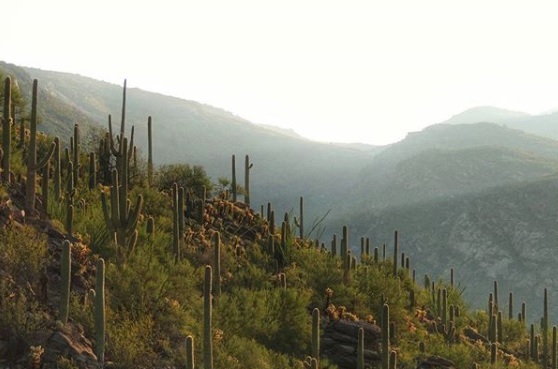Last updated: June 19, 2019
Lesson Plan
Nurse Trees and Saguaros

- Grade Level:
- High School: Ninth Grade through Twelfth Grade
- Subject:
- Math
- Lesson Duration:
- 90 Minutes
Objective
To introduce the important relationship between nurse trees and saguaros, while learning about percentage and how to create several graphs using Excel.
Background
A saguaro begins its life as a shiny black seed no bigger than a pinhead. But what it lacks in size it makes up for in numbers. One saguaro cactus produces tens of thousands of seeds in a year and as many as 40 million in its lifetime of 175 to 200 years.
From the start, odds against survival are great. Out of the millions of seeds that a saguaro produces, few plants survive to adulthood. Seeds and young saguaros have the best chance for survival if they are cared for by nurse trees like palo verde and mesquite. Seedlings growing under these plants are shaded from the intense sunlight, blanketed from winter cold, and hidden from hungry rodents, birds, and other animals.
Preparation
Click on the Saguaro Data Guide and then go to the link provided.
Enter the code 2225391 on the search bar and click on Section 17 Saguaro Monitoring.
Click on Section 17 Raw Data to see and familiarize yourself with the data that the students will be working on.
Materials
Contains complete Park data for teachers
Download Saguaro Data Guide Section 17 Data Year 2011
Saguaro Data Guide Section 17 Data Year 2011 Practice Set
Download Section 17 Practice Set
Contains the data for students to evaluate and create graphs from.
Download Modified Students Saguaro Data Guide
Lesson Hook/Preview
Saguaros grow very slowly. In Saguaro National Park, studies show that a saguaro grows between 1 and 1.5 inches in the first eight years of its life. These tiny, young saguaros are very hard to find as they grow under the protection of a “nurse tree”, most often a palo verde, ironwood or mesquite tree.
As the saguaro continues to grow, its much older nurse tree may die. Some scientists believe that competition from the saguaro may lead to the death of the nurse tree by taking water and nutrients from the soil in the immediate area.
Procedure
Day One
#1: Allow students to look at and make general observations to the Section 17 practice data set.
#2: Discuss observations in class and ask questions pertaining to the activity.
#3: Talk to students about nurse plants and saguaros.
Possible Questions:
What are nurse plants?
How do you think a nurse plant and saguaro help each other?
Why does a saguaro need a nurse plant?
Looking at the data, about how many saguaros have a nurse plant?
Which kinds of nurse plants are present?
#4: Introduce the topic percent as well as basic excel procedures. Let students play around with the data sheet in excel.
Day Two
#1: Looking at the Section 17 data, record which plants are present from FID 0-200.
#2: Ask students: Of all the plants listed, which ones do you think are nurse plants? Why? How do you know?
#3: From FID 0-200, how many nurse plants are there in total? How many saguaros? What percentage of saguaros have nurse plants? How about just mesquite trees? Palo verdes? Creosotes? Saguaros?
#4: Look at plots A8, B8, C6, C8, E8, F8, G8, and H8. Which plots have more nurse plants? Show this using a bar graph. Convert the number of nurse plants present in each plot to percent.
#5: Compare the presence of each kind of nurse plant by counting how many there are in each plot. Illustrate using an appropriate graph.
#6: Create a pie chart comparing the presence in percent of different nurse trees in C plot.
Vocabulary
Saguaro- a giant columnar (cylindrical) cacti that is native to the Sonoran Desert
Nurse Plant- plant that helps create a more suitable environment for young seedlings to grow and survive in a harsh environment like the desert by giving them shade, etc.
Percent- means parts per hundred, %
